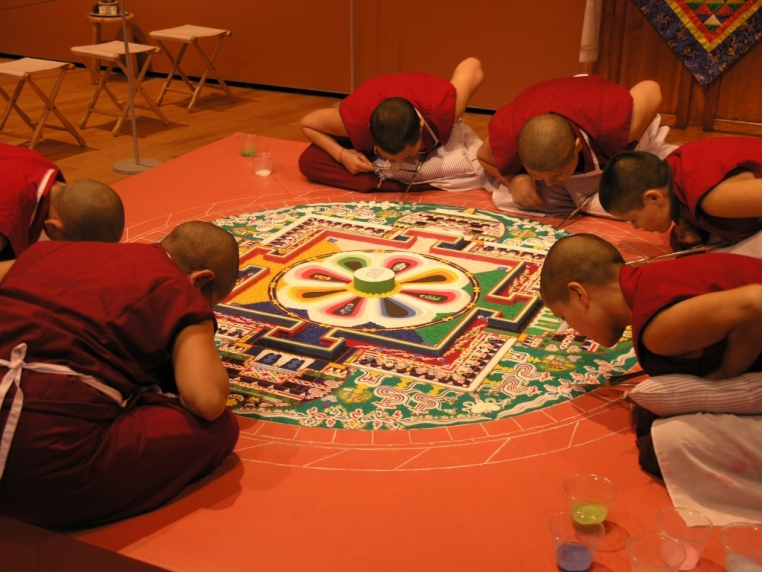
In February/March 2005 Wellesley College, in cooperation with Trinity College, hosted eight Tibetan Buddhist nuns including Ani Ngawang Tendol, their translator and group leader, from the Keydong Thuk-Che-Cho-Ling Nunnery in Kathmandu, Nepal, in the creation of a sandmandala, the Avalokitesvara mandala of compassion. Over twenty departments, programs and nonprofit institutions joined together to support this sacred art event at Wellesley College. The Keydong nuns are among the first Tibetan Buddhist women monastics to learn this sacred art practice which was traditionally reserved for monks only.
A mandala is a graphic representation of the perfected environment of an enlightened being: in this case, Avalokiteshvara,the Deity of Compassion. A mandala can be read as a bird’s-eye view of a celestial palace, with a highly complex and beautiful architecture adorned with symbols and images that represent both the nature of reality and the order of an enlightened mind. At a deeper level then, a mandala is a visual metaphor for the path to enlightenment: its viewers “enter” a world artfully designed to evoke attitudes and understandings of their own deepest nature.
A mandala is both a microcosm and macrocosm and includes the individual and the universe in its transformative power. Upon completion of the intricate designs and complex iconography of the mandala, it is dismantled and the sand is offered back to the earth as a powerful symbol of the transitory nature of life.
The concept of the mandala has, in the twentieth century, found a wide range of correspondences: within Jungian psychology, the mandalarepresents an inner wholeness which we all seek to restore.
Within modern art, the mandala painting uses geometric shapes to represent a vibrational landscape within the human soul. Within political science and peace studies, the mandala refers to the interpenetration of the personal with the political, of contemplation with action, and the inherent deep connection between mind, body, and spirit.
This project was made possible by the following Wellesley College department and programs: Office of Religious and Spiritual Life, Office of the President, Davis World Fund, Committee for Lectures and Cultural Events, Art Department, Department of Religion, Department of Political Science, Office of the Dean of Students, Theater Studies Department, Wellness Committee, Cultural Advisors’ Network, Slater Center, Students for a Free Tibet, WASAC, CSA; and the following institutions: Trinity College, Brandeis University, Lesley University, Ruah Spirituality Institute, Boston Clergy and Religious Leaders’ Group for Interfaith Dialogue.
Wellesley Project Director: Ji Hyang Sunim
Trinity Project Director: Judy Dworin